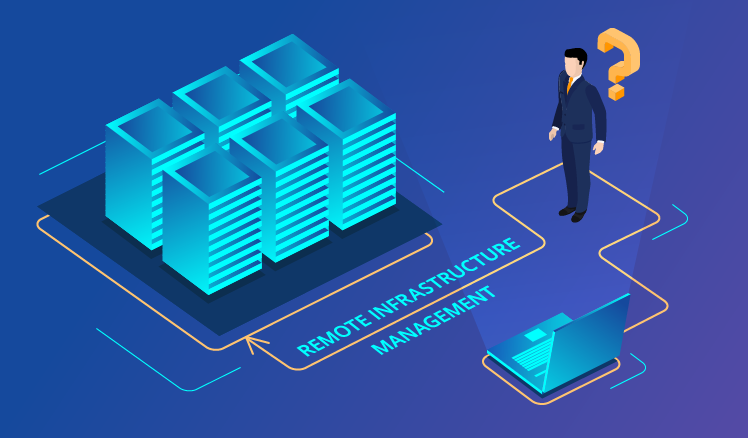The modern digital organization relies on IT infrastructure more than ever to deliver both internal and customer-facing services. However, managing the operational performance of this infrastructure is not easy. As things stand, the current technological advancements will continue their rapid change for the foreseeable future. And there is no reason to believe it will slow down at all. While these technologies are integral to business innovation, they also increase complexity and reduce employee productivity.
As a result, cloud-based infrastructure, both public and private, DevOps, Site Reliability Engineering, and containerization are some of the new IT archetypes being adopted by organizations to ensure that they leverage the opportunities presented to them to evolve into, and remain, market leaders.
IT infrastructure and its management
Information Technology infrastructure is defined as the components required to operate and manage enterprise IT environments, including hardware, software, networking components, persistent data storage, and an operating system (OS), all of which are used to deliver IT solutions and services.
There are several types of IT infrastructure, including:
- Cloud computing: Cloud computing is described as the act of running workloads on IT Infrastructure within the cloud. In other words, cloud computing is a function. On its own, it is not a technology. IT infrastructure, as defined above, must be constructed and deployed for a cloud-computing ecosystem to function.
- On-premises computing: This computing model consists of an in-house server framework used to host local software and run in-house workloads. An on-premises data centre can also be used as a private cloud where clients have access to many public cloud-computing services, but with additional control, security, and customization not available to the public.
Moreover, IT infrastructure management is the holistic management of the IT infrastructure, including hardware, software, networking components, data storage, OS, and data. It also includes the management of the relevant human resources, policies, procedures, and external contacts for overall effectiveness. Ergo, the IT infrastructure management paradigm consists of the control and management of the overall infrastructure, from physical components to human resources and policies and procedures.
IT infrastructure management best practices
The term “best practices” is defined as a “set of guidelines, ethics, and ideas that represent the most efficient, or prudent course of action, in a given business situation.” Additionally, best practices aim to serve as a general framework for a variety of scenarios. For instance, the best practices for IT infrastructure management denote the most effective and efficient way to maintain and control all aspects of the IT infrastructure lifecycle. This best practices’ list also includes safety protocols such as ensuring that the computer servers are powered down and unplugged before adding or swapping out hardware components.
Now that we have an in-depth understanding of IT infrastructure, management, and best practice definitions, let’s consider the top 3 IT infrastructure manager best practices as a mechanism to improve our knowledge of competent IT infrastructure management.
1. Knowledge gathering
Knowledge gathering can be more complicated than it sounds. If you gather too little information about your IT infrastructure, you run the risk of missing critical information to base your infrastructure management model, method, and protocols. The counterweight to too little information is too much information. It is easy to become paralyzed by too much information, resulting in management protocols that are too resource-intensive and detailed to implement successfully.
For instance, if you’ve never configured a Cisco ISR router before, it can become remarkably daunting if you read the in-depth technical manual from cover to cover before starting the configuration process. The same principle applies to determining what must be included in your infrastructure operational and management model and what must be left out. Fortunately, the experience is the best predictor of what to incorporate and what to leave out.
2. Create and implement standards consistently based on the knowledge gathered
Once the knowledge gathering phase has been completed, the next step is to create operational and management standards. It is essential to note that there will be similarities and differences between standards and configurations at different organizations. Therefore, it is necessary to personalize and customize your IT infrastructure management standards and configurations at an organizational level, such as increasing the clarity of configurations and security standards.
Once these standards have been created, the next step is to ensure that they are consistently implemented. Having clear, consistent standards and configurations is vital for IT engineers and other employees tasked with managing the IT infrastructure. For example, if your networking framework uses Cisco DNA, there is a network management and command centre for the product; thereby, ensuring consistency across the organization by provisioning and configuring your network. Therefore, it is vital to use similar products as part of your infrastructure standards and configurations to ensure consistently implemented and adhered to standards across the organization.
3. Document heavily
In-depth, detailed documentation is integral to the successful implementation of IT infrastructure management standards and configurations. Unfortunately, it is common for IT departments to ignore this best practice or scribble down a few pointers by formally documenting the operational and management processes. However, it is imperative to ensure that the IT infrastructure documentation is detailed enough so that new IT engineers (employees and consultants) are able to onboard and ramp up quickly, efficiently, and effectively.
As part of the thorough documentation process, it is essential to include infrastructure Business Process Flow diagrams, networking diagrams such as SD-WAN diagrams, and other infrastructure diagrams. Lastly, it is vital to fully document individual component configurations so that replacing individual components is achievable in a short space of time, reducing the overall infrastructure downtime.
Final thoughts
The primary aim of IT infrastructure management is to improve uptime and reduce downtime metrics. The longer a system is down due to failures and regular maintenance, the greater the cost to the client and the infrastructure management company. Therefore, implementing these three best practices as a mechanism to improve your IT infrastructure management is imperative to ensure optimal infrastructure and system functioning over time.

